Edinburgh
Cannonmills
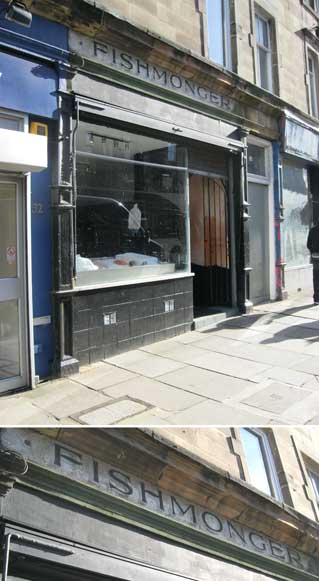 2012 images
2012 images
The crazing of the paint around this shop sign
indicates that it has been there for a long time; and, yes, the shop
still sells wet fish.
'The Old Town': The Royal Mile
The Royal Mile (Lawnmarket, High Street,
Cannongate) stretches from the Castle down to Holyrood Palace. The Old
Town surrounds it and is described as the medieval part of Edinburgh.
It certainly became clear that it is a treasure trove of historic
lettering. The street plan is a 'fishbone layout' of the Royal Mile as
the backbone and many small passageways and alleys (known as Closes)
running off it on each side. The stone buildings of the city lend
themselves to signs painted directly on the surface. The antiquity and
weathering means that many examples are fugitive, but indicate thriving
businesses in past centuries.
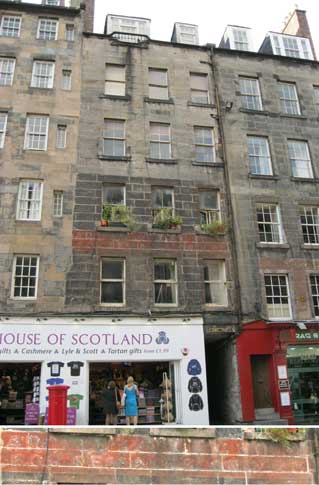
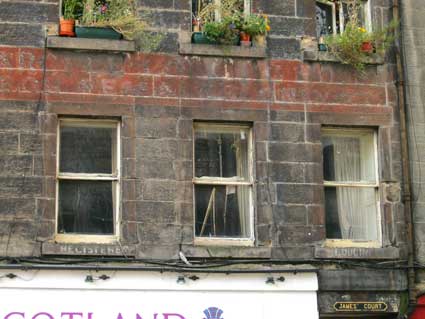
The above signs, over James Court in Lawnmarket, took
some working out. On the red-painted background:
'ARGYLE LODGING HOUSE
FOR FEMALES ONLY'
and painted on two of the first floor window sills:
'REGISTERED ...
LODGINGS'
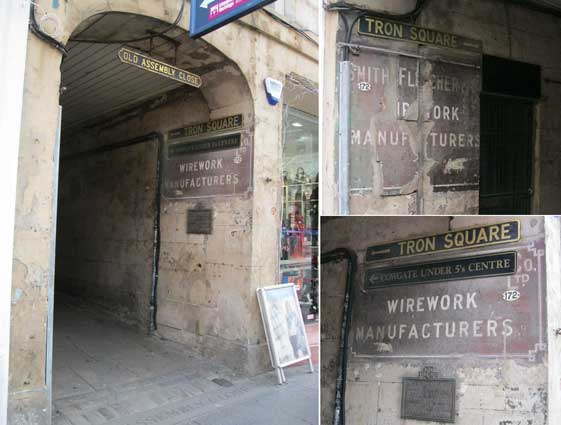
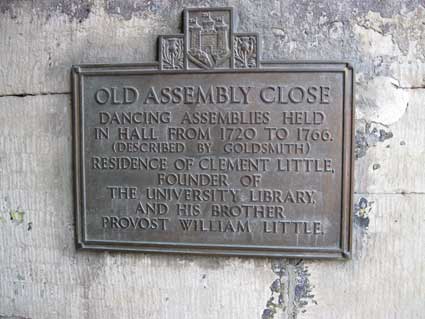
Old Assembly Close is labelled by the gold-on-black,
hanging, shaped nameplate and on the modern stone threshold. Modern
signs within the archway partially cover a painted trade sign on one
side and patchwork mortar obliterates some lettering on the other side.
between them we can construct:
'SMITH FLETCHER & CO.
LTD.
WIREWORK
MANUFACTURERS'
with a pointing hand, the whole sign inside a
deco-style border. The small oval numeral '172' indicates that all
these entries have been recorded and numbered. The helpful plaque
showing historical information is typical of many to be found in the
city.
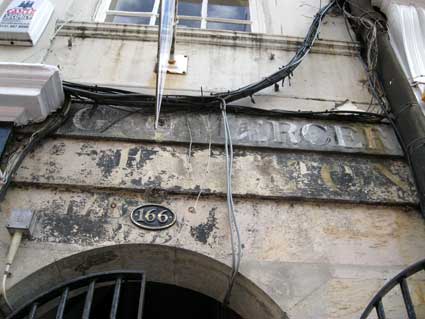
Above this arched entry to a Close are three bands of
lettering, partially obscured by dodgy-looking cabling:
'GEO. MERCER'
is at the top in serifcapitals with a drop shadow. Even
larger capitals appear below, although we can only be sure of the 'ON'
at the end; the lettering running under the '166' oval is unreadable.
As are most of the characters painted within the arch, left and right
(shown below).

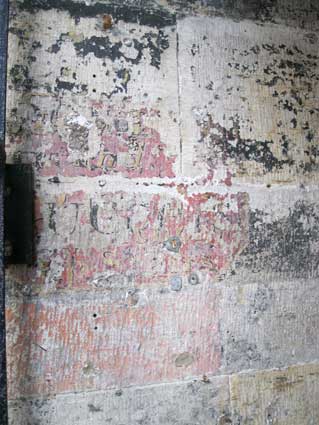
Here are similar traces from other Closes running off
The Royal Mile.

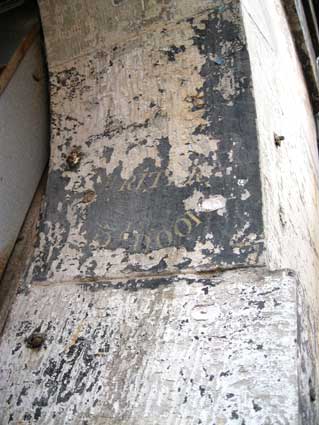
Burnett's Close (below) once displayed its name running
round the arch (still visible beneath the nameplate) and has lettered
on the lintel entry:
'MARY'S CHAPEL'
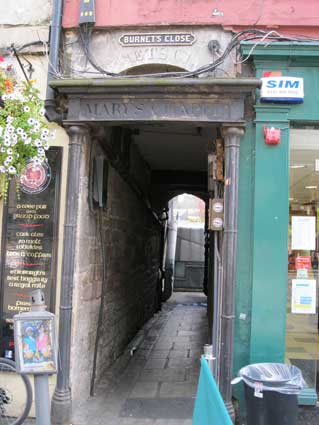
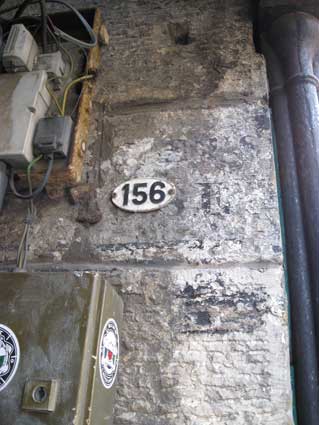
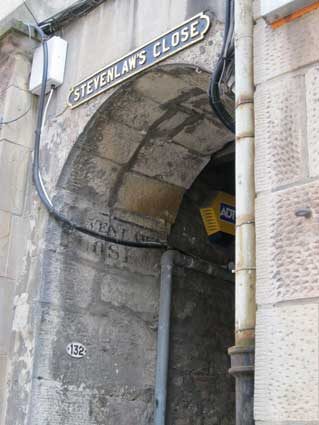
Stevenlaw's Close has its name painted on the inside of
the arch stonework (beneath the inevitable modern cable).
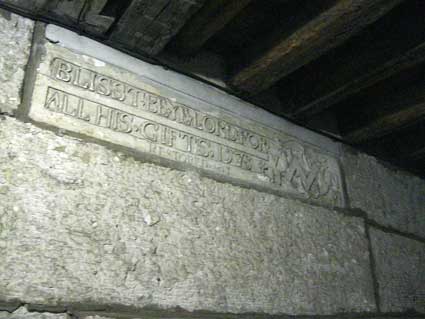
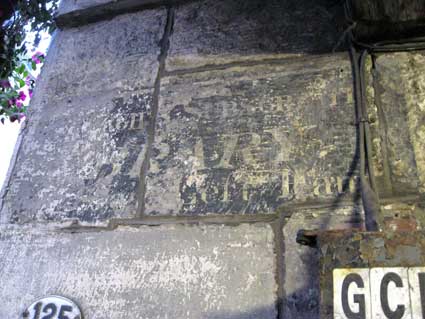
Left: lurking high up in
one Close (and see also the similarly quirky spelling on John Knox
House, further down the page):
'BLISST.BE.YE.LORD.FOR
ALL.HIS.GIFTS.1578
RESTORED 1813[?]'
Right (above):
'...AGH SUBSCRIPTION
LIBRARY
... Left Hand [?]'
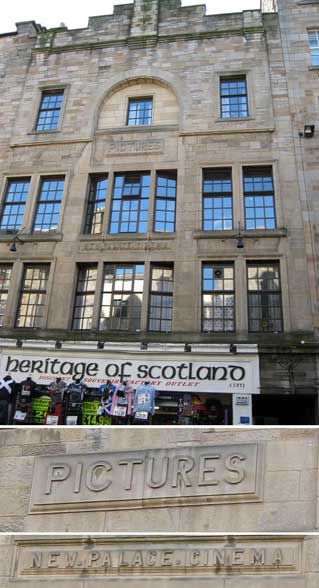 'PICTURES
NEW PALACE CINEMA'
'PICTURES
NEW PALACE CINEMA'
Paisley Close has a very ornate carved support for an upper bay window
which features a portrait of sometime resident of the city, Robert
Burns (he's also just visible under the awning to the left); also a
scroll bearing the quotation:
"HEAVE AWA CHAPS,
I'M NOT DEAD YET"
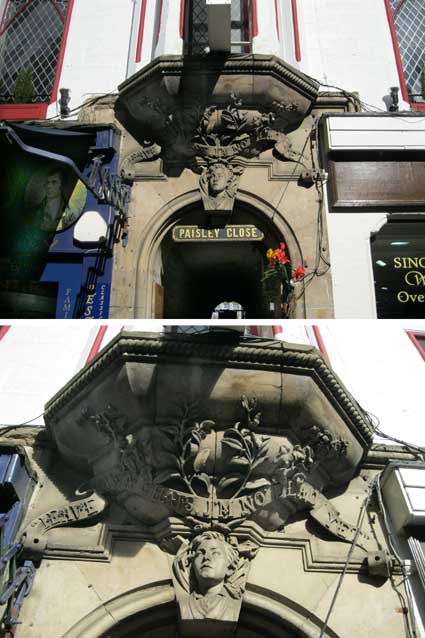
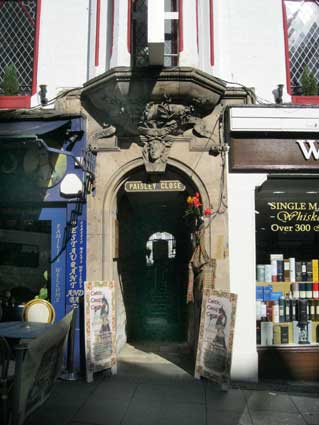
John Knox House is Edinburgh's oldest Royal Mile
mansion: the home of Mary, Queen of Scots' Catholic goldsmith and the
final resting place of Scotland's controversial religious icon. It is a
very striking building and bears two main sets of lettering. In gold
characters
above the window:
'LYFE . GOD . ABVFE . AL . AND . YI .
NICHTBOVR . AS . YI . SELF'
which we contrue as
Scottish for: "Love God above all and your neighbour as yourself".
There is a crest above surrounded by the letters: 'I M M A'. Past the
stone staircase to the right is the crest bearing the following:
'GOD . SAVE . THE .
KING
IR6 ... AR
1606
BEATI . PACIFIC'
We think that the 'I'
can be read as a 'J' and stands for 'James Rex the 6th' [of Scotland
and James the first of England]. Perhaps the 'AR' stands for 'Anno
Rex'? The Latin at the bottom means: 'Blessed are the peacemakers'.
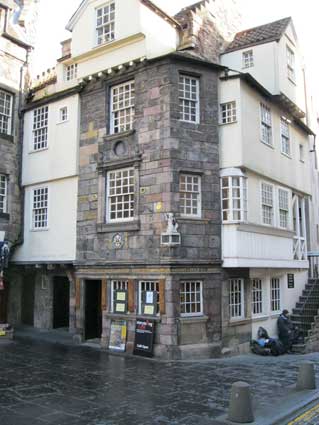

The stonebuilt water cisterns with their gargoyle-like
spouts are found in the area and, thanks to informative plaques, tells
their own story.
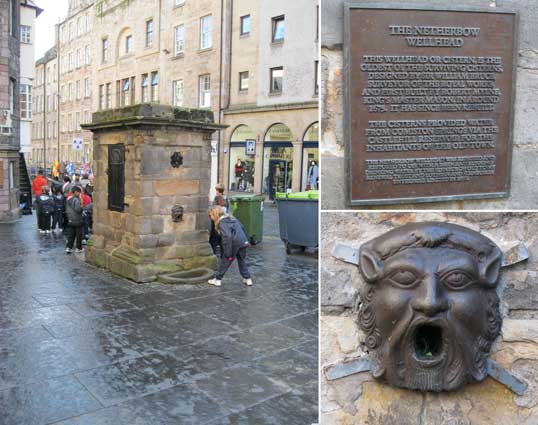
The Netherbow Wellhead close to John Knox House (the
Picure Palace is in the background).

The High Street Wellhead boasts the masks of comedy and
tragedy on either side, once acting as water spouts.
'The Old Town': St Mary's Street
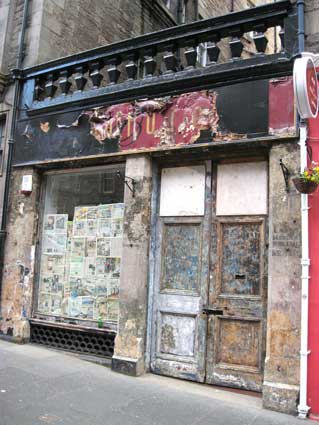
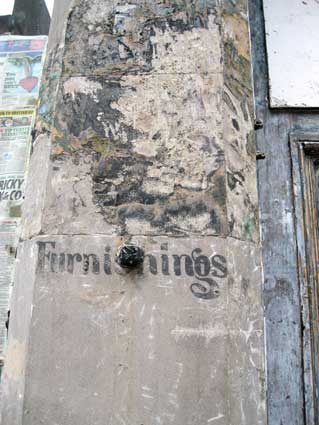
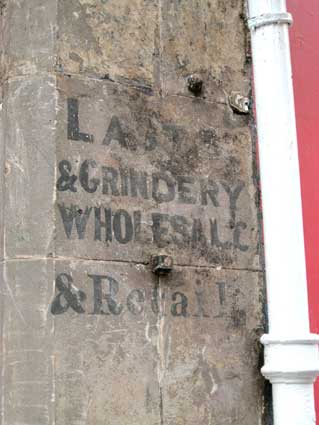
This unprepossessing shop-front has the remaining word
'Furnishings' (with an impressive flourishes on the
'g') visible on the left of the doorway. On the right is:
'LASTS
& GRINDERY
WHOLESALE
& Retail'
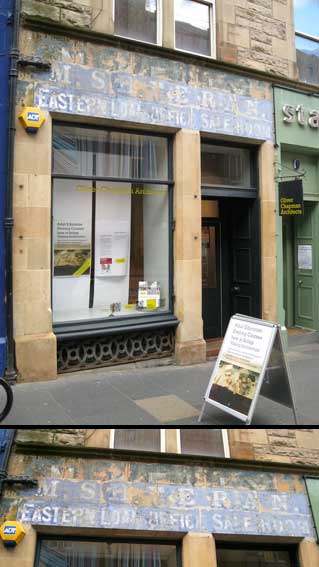
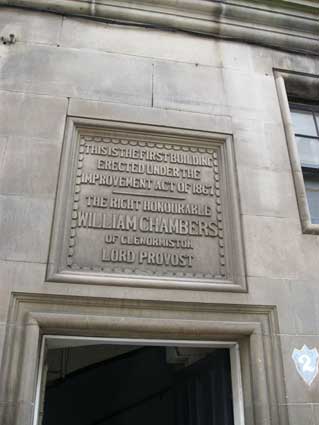
Nearby is this somwhat smarter frontage with a worn
pice of lettering, white on pale blue above (perhaps exposed prior to a
new shop sign being fitted):
'M. SHEERAN.
EASTERN LOAN OFFICE SALE ROOM'
The image above right is on a building near the top of
St Mary's Street:
'THIS IS THE FIRST BUILDING
ERECTED UNDER THE
IMPROVEMENT ACT OF 1867
----
THE RIGHT HONOURABLE
WILLIAM CHAMBERS
OF CLENORMISTON
LORD PROVOST'
Georgian 'New Town'
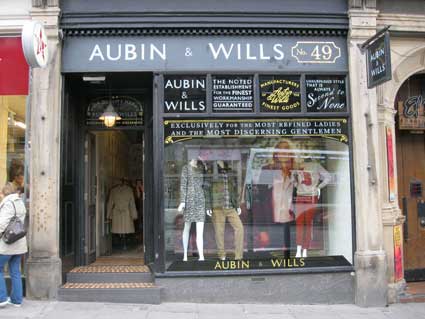
No. 49 Hanover Street is home to a much-lettered
clothier's shop. At the top of the shop window in white and gold on
black:
'AUBIN & WILLS
'THE NOTED ESTABLISHMENTFOR THE FINEST WORKMANSHIP -
GUARANTEED
MANUFACTURERS OF THE FINEST GOODS (surrounding the
business namestyle)
UNSURPASSED STYLE THAT IS ALWAYS Second to None
EXCLUSIVELY FOR
THE MOST REFINED LADIES
AND THE MOST DISCERNING GENTLEMEN'
Now faded and oft-ignored there is even scrolling, cursive lettering in
the grey band below the window:
'The Brand to...
Aspire to...
When Looking...
The Highest Quality &...
Workmanship
Austin
& Wills'
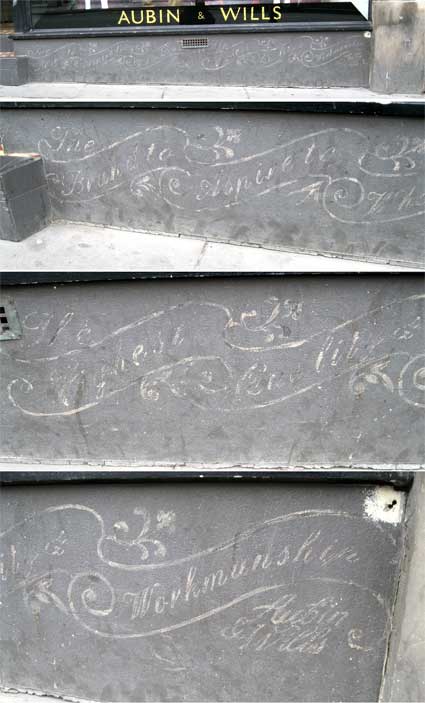
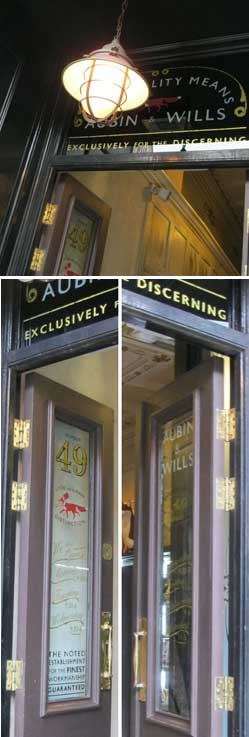
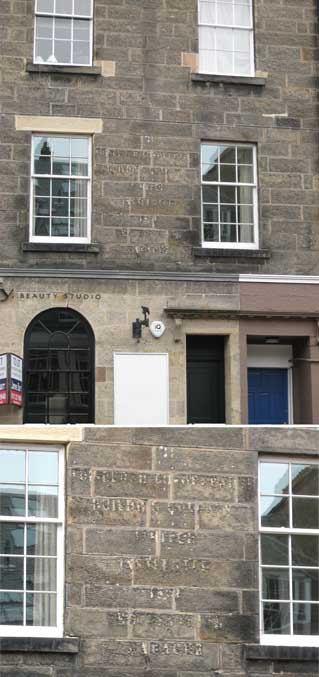
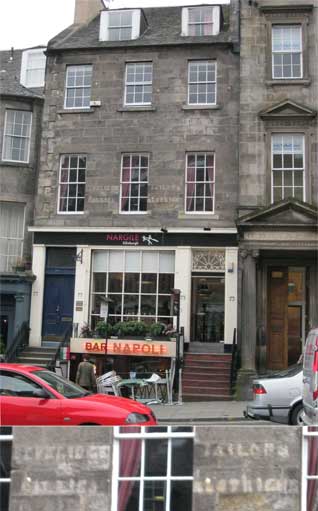
Above left: we have
deciphered the
following from these traces:
'EDINBURGH COOPERATIVE
BUILDERS COMPANY
LIMITED
INSTITUTED
1861[?]
???
MANAGER[?]'
And above right:
'BEVERIDGE
&
DILLIES[?]
TAILORS
&
???'
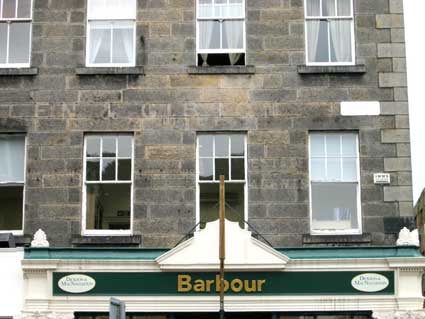
'...LEN & GIBION
VALUERS ... AUCTIONEERS[?] ...
ESTATE AGENTS'
The last three are between the middle bars of the
windows. We're not confident about 'Auctioneers'.
'The Old Town': Grassmarket

The top of the hill of Grassmarket is also called
Victoria Street and near the top is a list of cities in ghostly
lettering (with a gap where the stonework has been repaired/cleaned) to
the left of the green door:
'BRANCHES
AT
GLASGOW
DUNDEE
ABERDEEN
LONDON
BIRMINGHAM
CARDIFF
HULL
LEEDS
...
SHEFFIELD
BELFAST
DUBLIN'
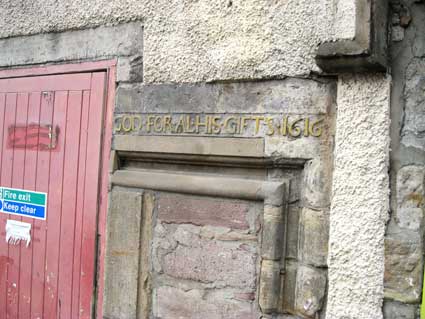
Down the hill, it becomes West Row and this enigmatic
insciption can be seen:
'GOD.FOR.AL.HISGIFTS.1616'
Candlemaker's Row
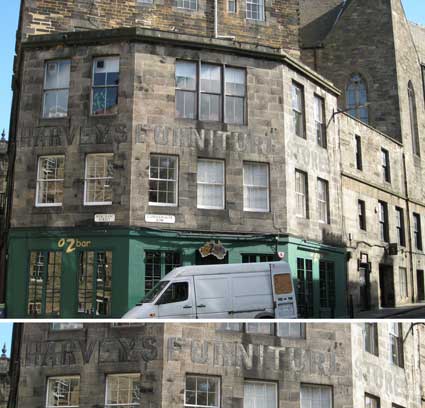
'HARVEY'S FURNITURE STORES'
is emblazoned in capitals across the three faces of the
building approached up the hill of Candlemaker's Row from Grassmarket.
George IV Bridge rises above the building to the left. Below left: the
fainter lettering running along the building:
'HARVEYS SHOWROOMS ... GEO. IV BRIDGE'
Below right: lettering
between the doors:
'JAMES HARVEY & SON
AUCTION SALOON
UPSTAIRS'
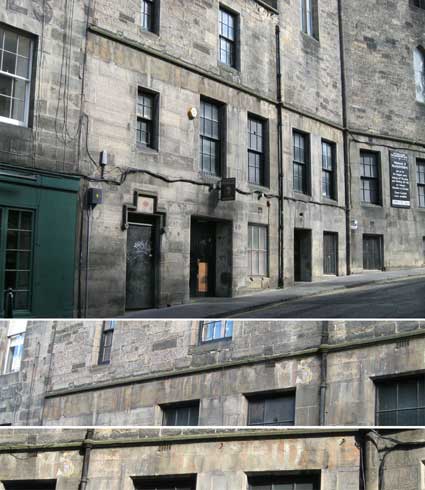
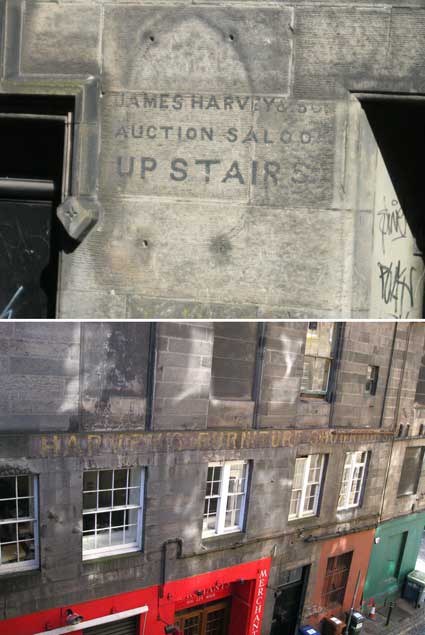
And finally, in gold capitals, the business advertises
itself to passers-by on George IV Bridge:
'HARVEYS SHOWROOMS'
George IV Bridge
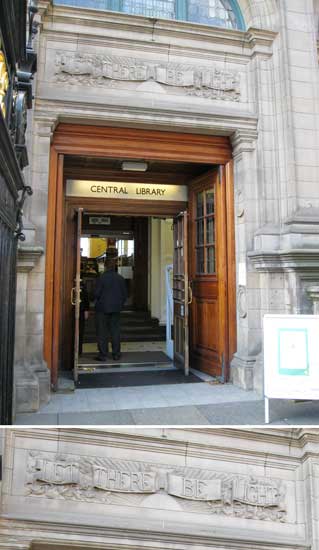
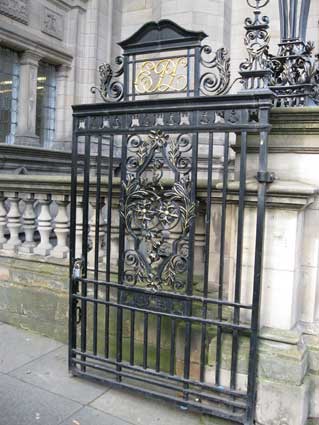

A few yards from the bridge is the central Edinburgh
Public Library with its ('EPL') monogrammed, ornamental gates and proud
motto
carved in the
stonework above:
'LET THERE BE LIGHT'
2 West
Port (Grassmarket area)
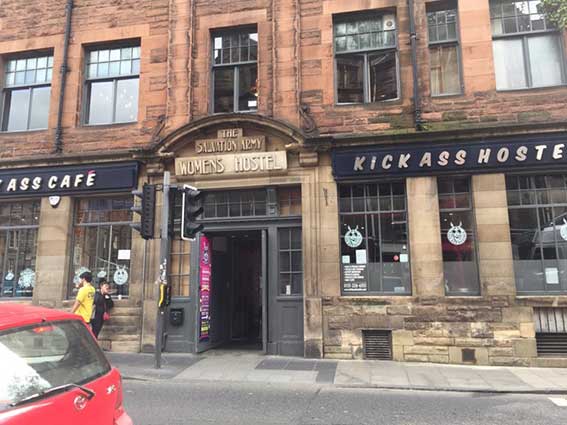 An unpromising recent branding of 'Kick Ass Hostel' for:
An unpromising recent branding of 'Kick Ass Hostel' for:
'THE
SALVATION ARMY
WOMENS HOSTEL'
above the entrance.
Lady Lawson Street
 Above: the entrance to:
Above: the entrance to:
'THE EDINBVRGH
COLLEGE OF ART'
from Lady Lawson Street. The curiously archaic use of a
'V' for a 'U' is mirrored in the way in which a skirt wall crosses a
paved corner ending in a large pillar with ball finial – and then is
pierced with a classical entrance-way for pedestrians.

Search Ipswich
Historic Lettering
©2004 Copyright
throughout the Ipswich
Historic Lettering
website: Borin Van Loon
No reproduction of text or images without express
written permission






 2012 images
2012 images













 'PICTURES
NEW PALACE CINEMA'
'PICTURES
NEW PALACE CINEMA'























